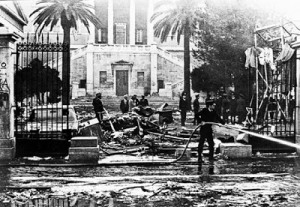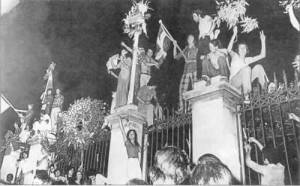 From the start in 1967, the junta, trying to control every aspect of
politics, had interfered with student syndicalism, banning student
elections in universities, forcefully drafting leftist students and
enforcing non-elected student syndicate leaders in the national
student’s syndicate, EFEE. These actions eventually created a fierce
anti-junta sentiment among students that was first manifested by the
suicide-protest against the junta of geology student Kostas Georgakis in
1970 in Genoa, Italy.
From the start in 1967, the junta, trying to control every aspect of
politics, had interfered with student syndicalism, banning student
elections in universities, forcefully drafting leftist students and
enforcing non-elected student syndicate leaders in the national
student’s syndicate, EFEE. These actions eventually created a fierce
anti-junta sentiment among students that was first manifested by the
suicide-protest against the junta of geology student Kostas Georgakis in
1970 in Genoa, Italy. On 21 February 1973, ...
On 21 February 1973, ...law students went on strike and barricaded themselves inside the buildings of the Law School of the University in the centre of Athens demanding the cancellation of the law that imposed drafting of “subversive youths”, as 88 of their colleagues had been forcefully drafted. The regime ordered the police inside the Law School and many students suffered police brutality. The events at the Law School are often cited as the prelude to the Polytechnic uprising.
On 14 November 1973, students at the National Technical University of Athens (also known as the Athens Polytechnic or Polytechneion) went on strike and started protesting against the military regime. There was no response so the students barricaded themselves in and built a radio station (using materials from the laboratories) that repeatedly broadcasted across Athens: “This is the Polytechneion! People of Greece, the Polytechneion is the flag bearer of our struggle and your struggle, our common struggle against the dictatorship and for democracy!” (Etho Polytechneio! Lae tis Elladas to Polytechneio einai simaioforos tou agona mas, tou agona sas, tou koinou agona mas enantia sti diktatoria kai gia tin Dimokratia). Leftist, later to be politician, Maria Damanaki was one of the major speakers. Soon thousands of workers and youngsters joined them protesting inside and outside of the Athens Polytechnic.
Gate Athens Polytechnic
By Wednesday, 14 November, 1.500 students had barricaded themselves inside the Polytechnic. Tension grew by the hour and throughout Thursday sympathizers old and young converged on the school next to the Archaeological Museum. By late Friday, 16 November, thousands of people were filling the area stretching from Panepistimiou Street all the way to the Alexandras Avenue intersection.
Witness accounts disagree as to which end of Patission Street the teargas canisters came from but the asphyxiating fumes had already started to terrify the crowd into headlong flight even before the first tanks appeared on Patission Street from the direction of Alexandras Avenue.
In the early hours of Saturday 17 November 1973, about 25 AMX 30 tanks arrived at the Polytechnic. One took position right in front of the main gate. Fifteen minutes later, a delegation of the students requested for 30 minutes to evacuate the school grounds but they were only given 15. Less than then ten minutes later the AMX 30 tank crashed through the gate of the Athens Polytechnic.
Polytechneion 17th November 1973
The events were filmed by the Belgian journalist Albert Coerant who worked as a correspondent for Dutch and Belgian TV in Greece during the military dictatorship. Even though the film is quite dark it is clear enough to show that the tank crashed down the main entrance of the Polytechneion while students, who had climbed on the gate earlier, were still on it.
In recordings of the “free Athens Polytechnic radio” that was transmitting from the school grounds, a young man’s voice is heard desperately asking the soldiers (who he calls brothers in arms) surrounding the building complex, to refuse to obey the military orders and not to fight ‘brothers protesting’. The voice carries on to an emotional outbreak, reciting the lyrics of the Greek national anthem. Shortly after the tank entered the school grounds, the radio station ceased to transmit.
According to a, highly contested, official investigation after the fall of the Junta, no students of the Athens Polytechnic were killed during the incident and only a few were injured by the tank.
Unofficial accounts differ as to how many died in the tank invasion into the Polytechnic area but a number were killed in the immediate area of the school. A further number are estimated to have been killed in Patission Street by sniper fire from nervous military guards atop buildings and in what sounded like indiscriminate shooting that went on until the early hours of Saturday 17 November. According to unofficial accounts, at least 24 were killed (the number may be higher), hundreds were injured and almost 1.000 were arrested at the Polytechnic and at the Ministry of Public Order where students also were protesting.
Although several civilians (some of them children and even the case of an infant) are documented having been killed in the cross-fire of the Polytechnic uprising, there is no documented reference to any actual students of the Athens Polytechnic killed at the time. Despite this, in popular opinion tens (or even hundreds!) of students of the Athens Polytechnic were killed. It does not pay homage to the memory of those who were actually killed to fabricate fictitious victims.
Both on Sunday 18 and Monday 19 November 1973 a mass of soldiers and police prevented crowds from gathering in thecentre of Athens and there were tanks in strategic positions as well as surrounding the Parliament Building. All of Greece was put under martial law for one week preventing from more than four people gathering. There also was a curfew between 19:00 and 05:00 and a number of people were shot for breaking it. Around the country, 28 student organizations were dissolved and their assets were confiscated.
Every year the campus of the Polytechnic is closed on 15 November (the day the students first occupied the campus) and on 17 November, all Greek schools and universities are closed. Students and politicians lay wreaths near the monument within the Polytechnic that has the names of all Polytechnic students killed during the Greek Resistance in the 1940s inscribed (there are no names of students killed during the Polytechnic uprising).
The commemoration day ends with a demonstration that begins at the campus of the Polytechnic and ends at the United States Embassy.
Source
Originally posted at http://greekindependentnews.net/
Greece: 20.000 Students & Demonstrators on Polytechnic Uprising Anniversary
After an entire day of protests and events attended by 10's of thousands who demonstrated without any major incident, Greek police began a brutal crackdown.
Police attacked with teargas, sound grenades and batons injuring at least 7 protesters and two Vice-Gr journalists who were both sent to the hospital for care. 73 people were detained and 10 arrested.
VIDEO ''I Don't Pay Movement'' demonstrating for the 17th November
PHOTOS ''I Don't Pay Movement'' demonstrating for the 17th November
Police Violence at Exarcheia on on the 17th November
Δεν υπάρχουν σχόλια:
Δημοσίευση σχολίου